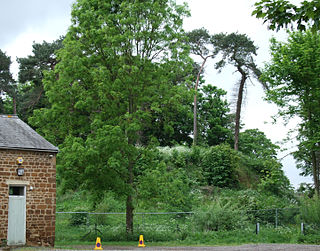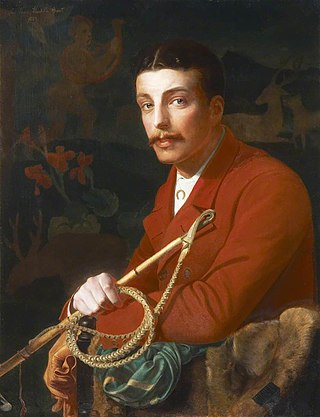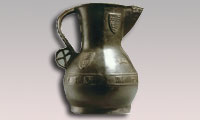
Baron Hesketh, of Hesketh in the County Palatine of Lancaster, is a title in the Peerage of the United Kingdom. It was created in 1935 for Sir Thomas Fermor-Hesketh, 8th Baronet, who had previously briefly represented Enfield in the House of Commons as a Conservative. As of 2010 the titles are held by his grandson, the third Baron, who succeeded his father in 1955. Lord Hesketh held junior ministerial positions in the Conservative administrations of Margaret Thatcher and John Major. However, he lost his seat in the House of Lords after the House of Lords Act 1999 removed the automatic right of hereditary peers to sit in the upper chamber of Parliament.

Earl of Pomfret was a title in the Peerage of Great Britain created in 1721 for Thomas Fermor, 2nd Baron Leominster. The title became extinct upon the death of the fifth earl in 1867.

Easton Neston is a large grade I listed country house in the parish of Easton Neston near Towcester in Northamptonshire, England. It was built by William Fermor, 1st Baron Leominster (1648–1711), in the Baroque style to the design of the architect Nicholas Hawksmoor.
Thomas Alexander Fermor-Hesketh, 3rd Baron Hesketh, KBE, PC is a British peer and UK Independence Party politician.

Rufford Old Hall is a National Trust property in Rufford, Lancashire, England. Built in about 1530 for Sir Robert Hesketh, only the Great Hall survives from the original structure. A brick-built wing in the Jacobean style was added in 1661, at right angles to the Great Hall, and a third wing was added in the 1820s.

Bury Mount Motte is the remains of an earthwork motte and bailey fortification or ancient castle in Towcester in Northamptonshire, and has been designated a Scheduled Ancient Monument. The Motte probably dates back to the 11th century when it was a Norman fortification, but over time it has been subject to neglect.
Fermor is a surname, a variant of Farmer. Notable people with the surname include:

Sir Thomas George Fermor-Hesketh, 7th Baronet was a British baronet and soldier.
Sir Thomas George Fermor-Hesketh, 5th Baronet was an English Conservative politician who sat in the House of Commons from 1862 to 1872.
Frederick Fermor-Hesketh, 2nd Baron Hesketh DL, was a British peer and soldier.

Henrietta Louisa Fermor, Countess of Pomfret, was an English letter writer.
General Thomas William Fermor, 4th Earl of Pomfret, styled The Honourable Thomas Fermor until 1830, was an officer in the British Army who fought in the French Revolutionary and Napoleonic Wars.

Sir William Fermor, 1st Baronet, was an officer in the Royalist army during the English Civil War. He stood for election as a Member of Parliament after the restoration of the monarchy in 1660, but died before a decision could be reached on whether he or another candidate had been elected.

William Fermor, 1st Baron Leominster, styled Sir William Fermor, 2nd Baronet from 1661 to 1692, was an English politician and peer.
Christian Mary McEwen, Lady Hesketh, OBE, DL was a British politician, journalist and educationist.

The Wenlok jug or Wenlock jug is a rare surviving example of an English bronze jug from the 15th century, with great significance for the study of bronze working in medieval England. Only two similar jugs are known in the UK. The Wenlok jug is the smallest of the three, but bears the earliest maker's mark for the English founder - possibly a bell founder - who cast it. The other examples are the Asante Ewer, which retains its lid and is held by the British Museum having been found at Kumasi in the Gold Coast in 1896 during the Anglo-Ashanti wars, and the Robinson jug, which was found in a farmhouse in Norfolk in the 1879 and is now in the collection of the Victoria & Albert Museum. All bear inscriptions in English and were made from leaded bronze, an alloy of copper, tin and lead, cast in a two-part mould in a similar manner using bronze spacers to separate the inner and outer moulds, with similar decorative motifs.

George Fermor, 2nd Earl of Pomfret (1722–1785), styled Viscount Leominster or Lempster until 1753, of Easton Neston house, Northamptonshire was Earl of Pomfret in the Peerage of Great Britain.

George Fermor, 3rd Earl of Pomfret was the third holder of the title of Earl of Pomfret in the Peerage of Great Britain.

Peter Denys was a British drawing master, later patron of the arts and landowner.

Sir George Fermor of Easton Neston was an English soldier and landowner.












